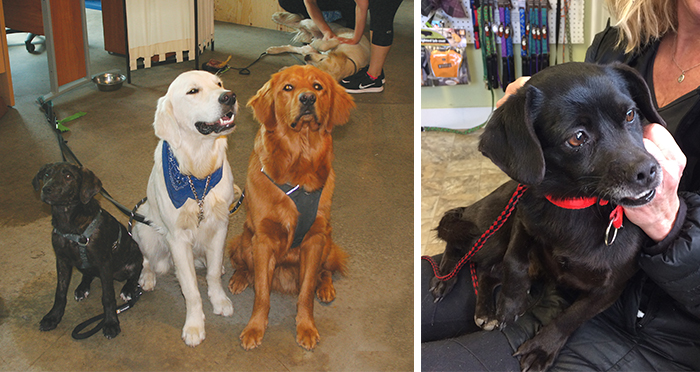(Photos above: (L) Montey, Bodie & Bodie at G5, (R) Dude at desperado with shoes &…)
Employers and employees, especially in Central Oregon, are acknowledging the advantages and benefits of allowing pets in the workplace. They help reduce stress. Encourage socializing. And get us moving. According to a Virginia Commonwealth University study, employees who bring their dogs to work produced lower levels of the stress-causing hormone cortisol.
Published in spring 2012, the study, led by Randolph Barker, a professor of management, was conducted at a dinnerware company in North Carolina, which sees 20 to 30 dogs a day on its premises. As the workday went on, research found average stress level scores fell about 11 percent among workers who had brought their dogs to work, while they increased 70 percent for those who did not.
According to research by the American Pet Products Manufacturers Association, about 20 percent of all companies in the United States allow employees to bring their furry friends along to the workplace. Expectedly, the most common pet guests at workplaces are dogs at 76 percent, followed by cats at 15 percent. The remainder are small pets like hamsters or fish.
Some of the most successful companies in the world welcome pets at their premises. While these include the usual suspects like Google, Amazon and Ben & Jerry’s that are renowned for their work culture and employee friendly policies, there are some companies that take their pets very, very seriously indeed.
In an experiment carried out by Central Michigan University researcher Christopher Honts and his team, test subjects were divided into groups that had a dog around them throughout a group task and those that did not. The groups which had a dog during their tasks showed significantly higher mutual trust, team bonding and intimacy than those that worked without one.
If any company in Central Oregon takes dogs seriously it’s G5 based in Bend. G5, provider of Digital Experience Management (DXM) software and services for the property management sector and ranked among North America’s 500 fastest growing technology, media telecommunications, life sciences and clean technology companies boasts approximately 60 dogs among its 240 G5 employees. On the G5 website you’ll find photos of the employee pets with the caption Our Extended Team of Tail Waggers.
So if your office isn’t pet-friendly, join us. We think job satisfaction will be at an all-time high.
5 Steps to a Pet-Friendly Workplace
Purina offers these steps for employers:
Have you wondered what it would be like to have dogs in your workplace? Or what it might be like to take a break and play with a cat during a long day? A pet-friendly workplace may be more attainable than you think. Just take the first step of drumming up enthusiasm for the idea among everyone at work.
1) Get management and staff on board.
Be sure to engage management upfront, so you have full support for your program from the top down. At Purina, our Site Services group maintains the program, but different workplaces will have different staff that will need to be involved. Start by reading our tips for getting your boss on board.
While management is important, so is employee enthusiasm. Talk to your coworkers and encourage any advocates at your workplace to stand behind you. If you’re an employer, read our tips for getting your employees excited about pets at work.
2) Work with management to establish guidelines.
Decide which types of pets can come to work. At Purina, we allow dogs and cats, but other workplaces may allow fish, birds or other types of pets. You also should establish a few “pet-free” areas in your office. At Purina, pet-free areas include restrooms, food preparation areas and conference rooms.
You may also want to ask about any pet allergies in the office and find ways to respect others’ comfort with pets.
Finally, make sure the guidelines encourage responsible pet ownership, such as adding rules for cleanup, providing healthy treats for people to feed and deciding where water bowls or litter boxes will go. Check out our Etiquette Guide to get started.
3) Do the paperwork.
Create an authorization and release form for employees to sign. See the Guidelines for Responsible Pets in the Workplace for helpful tips to set your employees up for success. We suggest your company contact your legal representative to create a version that suits your company’s culture and needs.
4) Get your cleaning crew on board.
That way, they can be sure to have the proper cleaning materials on hand for any accidents that might occur.
5) Adapt your facilities.
If you don’t own your facility, check with your landlord to make sure you can start a Pets at Work program. If you do own your facility, determine whether you want to enhance your space to further integrate pets.
Some of the things done at Purina include:
Provide space. If your workplace permits, provide a dog park so that pets (and employees) can take a moment to stretch their legs. If a dog park is not feasible, consider a large, grassy area that can be a dedicated space for pets to play.
Poop bag stands. Make it easy for employees to be responsible for cleaning up after their pet.
Leash ties. Provide posts or areas where leashes can be tied. It’s nice to have a space where employees can take a moment to be hands-free, especially if they have to quickly run into a pet-free area of the office, like the cafeteria.
Keep it inviting. Have treats or snacks on hand in lobby areas or other common spaces. Keep receptionists, security and other employees up-to-date on the guidelines for Pet Visitors in the Workplace. Make it clear which workspaces are pet-friendly.





